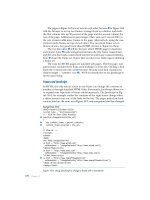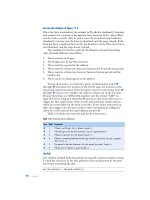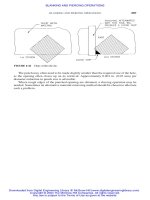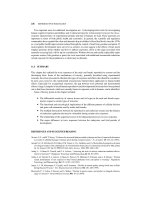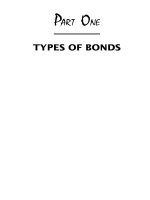Getting started in bonds 2nd edition phần 5 pps
Bạn đang xem bản rút gọn của tài liệu. Xem và tải ngay bản đầy đủ của tài liệu tại đây (292.96 KB, 31 trang )
108
original
issue discount
(OID)
the bond issue
was not issued at
par but instead
came to market
at a discount. If
you sell the bond
in the secondary
market, you
must check to
see if the price is
above or below
the accrued
amortization line
to determine if
you owe capital
gains tax.
PREFERRED STOCK
the income every year even if you haven’t gotten it yet. In
fact, due to any income deferral and the fact that some are
issued as original issue discounts (OIDs), the tax calculations on these nuggets can be pretty nasty. Hopefully,
whomever you buy fixed rate capital securities through
will do it for you.
There are three types that differ in how they are issued:
1. Preferred partnership securities.
2. Trust preferred securities (or capital securities).
3. Junior subordinated debentures.
And they are called by a boatload of acronyms:
MIDS
QUICS
QUIDS
QUIPS
SKIS
TOPrS
TruPS
Monthly income debt securities
Quarterly income capital securities
Quarterly income debt securities
Quarterly income preferred securities
Subordinated capital income securities
Trust originated preferred securities
Capital trust pass-through securities
Stay tuned for more witty creations. . . .
8
Chapter
It’s a Wrap:
Wrapper Products
W
e’re now moving from types of bonds to
investment vehicles you can use to invest
in bonds. Wrapper products are readymade financial portfolios, packaged for individual investors. They’re packaged by insurance companies,
banks, investment firms, and mutual fund companies
that fashion these portfolio packages-to-go for our
convenience.
The problem with wrapper products is that there
can get to be many layers (i.e., the financial intermediaries who produce these products). Each layer extracts
its fees, muffling the investment’s performance. (See
Figure 8.1.)
For instance, I’ve seen a mutual fund (wrapper portfolio) that invested in collateralized mortgage obligations
(a wrapper security: mortgages are packaged as mortgage-backed securities, and MBSs are then packaged as
CMOs) held in an investor’s wrapper account (explained
later in the chapter). The resulting yield to the investors
was about the same as if they’d gone out and bought a 3month Treasury bill, but the risk was much greater.
109
110
WRAPPER PRODUCTS
FIGURE 8.1 Wrapper products: layers of service fees affect yield.
Drawing by Steven Saltzgiver.
BENEFITS
Even in light of the disadvantages, the advantages are very
compelling.
Wrapper products offer:
✔
✔
✔
✔
✔
Low minimum investment.
Diversified portfolio.
Professional management.
Ease of investment.
Same advantages as institutional investors:
Faster access to breaking news.
Quicker trading.
Better pricing because trading in size.
Research and market reports from major wire
houses.
Pulse on big money’s market temperament.
When we invest in most wrapper products, we
pool our money together with a bunch of other folks
and engage a full-time investment professional to manage our collective cash. The significant size of this pot
enables the manager to benefit from institutional service, pricing, and access to information. These are advantages we as individuals could never hope to receive.
We can buy into a well-diversified portfolio for as little
as $500.
Performance
COSTS
Of course, there is a price for all of these inducements.
The cost includes an annual management fee, 12b-1 fee,
and in some cases an additional sales load. Management
fees are annual payments charged to cover fund expenses.
The 12b-1 fee is to support promotional activities; it is
usually paid out to other firms—for example, broker sales
concessions. The load is generally a one-time payment
that is either charged when you invest, a front-end load;
or charged when you sell, a back-end load.
Make sure the fees are reasonable. To help ensure
these costs are reasonable, the ever-vigilant Securities and
Exchange Commission (SEC) polices management companies to make sure they clearly disclose all investor costs
in the prospectus which must be given to investors before
they invest. So read your prospectus and make sure the
charges look sensible to you.
When I started in the business, sales loads of 81/2%
for stock funds and 43/4% for bond funds were not unusual. Now, 2% to 4% is more the norm, and there are
many well-performing no-load funds available.
111
front-end
load
mutual fund’s
sales charge that
is added onto
your purchase
price.
back-end
load
mutual fund
sales charge that
is subtracted
from the price
when you sell
your fund shares;
also known as a
contingent
deferred sales
charge (CDSC).
PERFORMANCE
The SEC also regulates how wrapper products report performance so that they don’t overstate their history in zealous marketing claims. When you evaluate a fixed income
product’s performance, you should look at both yield and
total return. (See Table 8.1.)
During the 1980s, an outcry from unhappy investors got the SEC’s attention. Thereafter, the SEC mandated that in addition to the current yield, funds had to
include the SEC yield in advertisements. The SEC yield
is calculated to prevent companies from falsely inflating
the portfolio’s yield by buying high-coupon bonds at a
premium. This yield calculation subtracts the premium
paid for the bond from the bond’s higher coupon’s income stream to give a more accurate reflection of the
true yield earned. Otherwise mutual fund managers
SEC yield
standardized
yield calculation
established by
the SEC that
subtracts the
premium paid for
any bonds within
the portfolio
from their higher
income stream.
112
–5.89
–5.57
3 Month
6 Month
3 Year
6.10
–1.27
–8.22
–7.66
–11.26
–4.78
–8.22
–1.27
6.10
3 Year
5 Year
10 Year
1.95
–6.77
–10.90
–7.66
1.67
–2.61
–5.68
High Yield
Bond Average
Return after Taxes on Distributions
6.28
1.14
–2.10
–4.36
3.06
–2.40
–7.70
–4.62
2.66
–0.76
–3.22
–1.92
High Yield
Bond Average
Return after Taxes on Distributions
and Sale of Fund Shares
Quarter-End Average Annual Total Returns (%)
as of 6/30/2002
10 Year
–6.98
–5.37
5 Year
–7.74
1 Year
1 Year
–6.27
1 Month
–5.37
Merrill Lynch High
Yield Master
Index II
Average Annual Total Returns (%)
as of 6/30/2002
Performance Summary
Return
before
Taxes
–5.57
YTD
Merrill Lynch High
Yield Master
Index II
Cumulative Total Returns (%)
as of 6/30/2002
TABLE 8.1
Bond Mutual Funds
113
could buy higher-coupon bonds to boost the fund’s
claimed yield. This would artificially inflate the yield because they paid a premium for the bonds and the bonds
would mature at par. The SEC recognized the economic
effect that the premium has on the total return.
The best measure to use when you’re gauging a
fund’s performance is its total return. This includes both
the interest you earn and how much the value of your
principal has changed in that time. Here’s an exaggerated
example: You could be attracted to a fund that is yielding
11%. Wisely, you look at the total return, which is –2%
because the price is down 13%. While past performance
doesn’t assure future performance, it’s smart to check a
fund’s long-term record, and not just invest in what has
been the hottest performer during the last quarter.
BOND MUTUAL FUNDS
Mutual funds are the most popular type of wrapper product. There are more mutual funds than there are stocks
listed on the New York Stock Exchange. In 1970, there
were 361 mutual funds; in 2001, there were 8,255 (2,188
of these were bond funds, and many more had some of
their assets invested in bonds).
In 1995, investors had $800 billion invested in fixed
income mutual funds. And what do we bond fund investors look like? The Investment Company Institute
(ICI) tells us that bond fund shareholders’ median age is
44, median household income is $60,000, and median financial assets are $75,000; 20% of us are retired and 64%
completed college. Whatever we really look like as individuals, there are two points that are very important for us
to keep in mind when we’re buying shares of a fixed income mutual fund:
✔ Even though it buys fixed income investments,
the fund’s dividend changes.
✔ The fund never matures. Its principal value is always market-dependent.
Investment
Company
Institute (ICI)
private company
that monitors the
mutual fund
industry.
114
WRAPPER PRODUCTS
Active portfolio management produces both of these
characteristics. Since securities are constantly bought and
sold and interest rates change, the fund’s payout and yield
are affected. And since mutual funds never mature, you
are not guaranteed you’ll ever get back the principal you
invested. While the number of shares you own stays the
same, the price you would get when you sell them fluctuates. These points should be carefully considered by investors who are counting on their interest and principal
being there.
Even when you buy shares of a mutual fund, it is of
premier importance to understand the securities it invests
in. Do not buy a bond mutual fund based on its yield
alone. The fund cannot act any differently from the bonds
it invests in. Therefore, by understanding the risks and
volatility involved in buying the type of bonds the fund is
invested in, you will understand how the fund will respond to changes in the investment environment.
There are two general mutual fund classifications:
open-end and closed-end. The first has no limits on how
many investor shares there are in the fund while the second has a fixed number of shares.
Open-End Mutual Funds
Fund has unlimited
number of shares.
Fund size grows and
contracts with changes
in investor demand.
Investors buy shares
from and sell shares
back to company.
Closed-End Mutual Funds
Number of shares is set
at issue.
Fund share price rises
and falls with changes
in investor demand.
Investors buy and sell in
secondary market like
stocks.
Closed-end fund shares are bought from the fund
company only in the original offering. After that they are
traded on listed exchanges just like shares of stock. Fluctuations in investor demand don’t affect the closed-end
fund manager’s investments. The overall size of the fund
only changes with changes in the secondary market of the
underlying securities’ prices that make up the fund.
Bond Mutual Funds
The number of fund shares never varies. Each share
has two values. One is the market value that it is trading
at on an exchange—the price we would pay for it. That
value is determined by how much investor demand there
is for the fund. The second value is determined by the
price of the underlying securities that the fund is invested
in. This is known as the share’s net asset value (NAV). Because often a closed-end fund’s market price is well below
the NAV, there is a trend toward closed-end funds converting into or merging with open-end funds.
Open-end mutual funds are the most common
type. Either you or your broker buys these funds directly
from the fund company. The size of an open-end fund
grows if investors are buying and declines if they are
selling, as well as with security price changes in the secondary market.
Another way to think of the difference is to look at
the equation:
Total $ in fund = Number of shares
× Each share’s NAV
With an open-end fund both factors change; with a
closed-end fund only the second factor changes because
the number of shares in the fund is fixed. You can imagine
how the added uncertainty of the open-end fund’s scenario can affect a manager’s investment strategy. The ebb
and flow can be dramatic. This unpredictable investor behavior, and therefore cash flow, can make a fund manager’s job difficult. Often, disadvantageous buy and sell
decisions can be forced on the manager since individuals
tend to buy into the fund after prices have become high
and to sell after prices have fallen.
Pricing
When you buy shares from or sell the shares back to an
open-end fund company, the price is based on the net asset value, not on investor demand. The NAV is computed
every night and is the total market value of all the securities within the fund plus any management fees. The NAV
115
net asset
value (NAV)
the dollar value
of all the
securities in a
mutual fund at
the close of the
day divided by
the number of
outstanding
shares.
116
WRAPPER PRODUCTS
for most funds is available in the Wall Street Journal or on
the Internet. If there is a front-end sales charge, it is added
to the NAV when you buy it; and if there’s a back-end
sales charge, it is subtracted from the NAV when you sell
it back. The NAV adjusted by the sales charge is called the
public offering price, aka POP.
NAV + Front-end sales load = Buying POP
NAV – Back-end sales load = Selling POP
This pricing method has advantages over closed-end
funds that trade on exchanges. What people think of an
open-end fund has no effect on its share price because the
fund will just get larger or smaller with investor demand
or disfavor, whereas the market price of a closed-end fund
is often based more on fickle investor sentiment than on
performance. Like any listed stock, the price goes up or
down depending on how much people want to own it.
Not understanding how funds operate can cause investors a lot of confusion and managers a lot of
headaches. The following are examples of how this is so
for closed- and open-end mutual funds.
Closed-end fund shares can trade at a premium or
at a discount from the NAV, often for reasons that are not
economically logical. When I worked on an investment
team managing a number of closed-end bond funds, investors would call asking why a fund was trading at a
discount. We had no idea, because the funds were performing beautifully. From an investment point of view,
the funds should have been trading at a premium because they had an attractive payout and were outperforming the bond market. However, the fund’s stock
price was trading at a discount because of low investor
demand that probably stemmed from not understanding
how to evaluate the fund’s performance. If you could
have raised enough money to buy the entire fund and
then sold the securities in the secondary market, you
could have made a ton of money. But, since we don’t
have millions of dollars to buy out a fund, we are at the
whims of other investors’ demand.
Bond Mutual Funds
In regard to our open-end funds, the question we’d
get asked a lot had to do with a fund’s share price dropping dramatically overnight. In fact, we were asked it at
the same time every month. The answer was that the fund
had just gone ex-dividend, meaning the dividend was
paid out to investors and was no longer included in the
fund. (See Figure 8.2.) The price of the fund would drop
by the amount of the dividend paid out (plus or minus
any market move). It confused people every month.
A little investing tidbit: It’s better to invest after a
fund goes ex-dividend because you’re investing in it
at a lower price. If you invest just before it goes ex,
you get the dividend; but you are also paying a
higher price. You are paying the fund money that it
then just hands back to you in the form of a dividend that you have to pay taxes on.
FIGURE 8.2 Open-end mutual fund price and dividend relationship.
117
118
WRAPPER PRODUCTS
In an open-ended fund the price is also affected by
the changing market values of the securities owned
within the fund. Every night the securities are valued. Figure 8.3 shows how both the price per share of the fund
and the dividend change over time. This is in contrast to
an individual bond, which has a fixed coupon (so the interest payout does not change) as well as a maturity
(when you know you will get the face value back). There
are no such assurances with a mutual fund.
Before you buy an open-end fund, the fund company
must send you a prospectus explaining the fund’s investment objective, how the fund invests, and its historical
record. The trend has been to make prospectuses much
shorter and easier to understand. It is in your best interest
to read the whole thing to make sure it’s really what you’re
looking for.
Performance
There are a number of tools you can use to judge a fund’s
performance. You can compare the fund’s yield and total
return to those of other funds and to appropriate indexes.
Lipper ranks funds according to how they have performed
within their competitive universe (funds with the same
investment objectives and guidelines, such as high yield
corporate bonds). Morningstar rates fund performance on
FIGURE 8.3 Prices and distributions.
Unit Investment Trusts (UITs)
a star system, five stars being the best. (See Figure 8.4.)
Both Lipper and Morningstar reports are available at most
libraries. Your financial service should also have access to
the information.
UNIT INVESTMENT TRUSTS (UITs)
Unit investment trusts (UITs) emigrated to our shores from
Scotland in 1961. Like mutual funds, they enable smaller
investors to buy into more diversified portfolios than they
could buy on their own. UITs differ from funds in that they
are not actively managed; a professional money manager is
involved only at the beginning when the UIT is issued. The
bonds are bought with the cash raised from selling the
trust’s units to investors. The bonds never change and are
held until they mature. Up until 1995, most UITs were
fixed income trusts. The most popular type of fixed income
UIT has been municipal bond trusts.
A UIT’s characteristics include:
✔ Fixed portfolio professionally selected.
✔ Steady payout.
✔ Known maturity.
FIGURE 8.4 Rankings and ratings.
119
120
WRAPPER PRODUCTS
A UIT’s prospectus stipulates what it can invest in,
the maturity, the sales charge, and terms for redemption.
It would be correct to say that UITs benefit from professional selection, not from professional management. Some
investors like the fact that someone isn’t meddling with
their investment. There’s no one trying to time interest
rates or forecast market sentiment. Investors can go to
sleep at night knowing exactly what securities they own.
The second benefit from a static portfolio invested in
fixed income securities is that as long as none of the
bonds are called or mature, the investors will receive the
same income payout. This is unlike mutual funds, whose
payout fluctuates depending on what is owned in the fund
during that payment period.
Toward the end of the fixed income UIT’s life, the
principal is gradually returned to the investors as bonds
are called or mature. Each unit receives back the same
proportional amount of the principal. Since there is less
principal earning interest, the income earned will drop
commensurably.
If you are considering a UIT, it is very important to
note the maturity dates and potential call dates to make
sure the investment still makes sense in view of your longterm goals. Does the timing of the principal repayment fit
your timetable? Also, keep in mind that callable bonds
tend to be called when interest rates fall and reinvestment
options are less attractive than the investment you were in.
The third benefit—a known maturity—means that,
unlike with mutual funds, you know you will get your
principal back by a certain date. UITs usually mature in
5 to 30 years. The minimum investment is generally
$1,000. They are not sold on a yield-to-maturity (YTM)
basis, but rather on a dollar price basis. Their return is
estimated using the current return, as well as a more accurate long-term return number that takes into consideration the securities’ market value, maturity, and
discount or premium.
There is no annual management fee since the trust
isn’t actively managed; however, there could be a maintenance fee of $1.50 to $2 per $1,000 invested. In addition,
UITs have historically carried sizable sales charges; but, as
Annuities
with mutual funds, the size of these charges has declined.
They now typically run about 31/2% to 5% of the total offering price for longer-term trusts. It is often difficult for
investors to recognize the size of the sales charge because
it is not broken out but is included in the purchase price,
so ask what the charge is. Retail brokers are told by their
management to make you aware of the charges. The
charges are also stated in the UIT’s prospectus. Since
transaction costs are minimal after the trust is assembled
and UITs don’t continually market their units to the public, there are no ongoing management fees or marketing
fees as there are with mutual funds.
A UIT’s units can be sold back to the issuer at the
public bid price at any time. That price is based on the
value of the underlying securities and could be higher or
lower than the price the investor paid. Most trust sponsors
voluntarily maintain a secondary market for their trusts.
The sales charge is paid when you buy the UIT, so there
usually is no redemption fee.
ANNUITIES
Annuities are another packaged product, but this one has
an advantage in that it allows your earnings to compound
tax-deferred. As we have mentioned, this can have a dramatic impact on the growth of your investment. It is also
likely that when the policy matures you will be retired
and in a lower tax bracket. However, as with all packaged
products, be wary.
A Wall Street Journal article, “Annuities 101: How to
Sell to Senior Citizens” ( July 2, 2002), chronicles how
“Annuities U” offers courses on how to sell this vehicle.
The course is popular since a salesperson who can get a
prospect to transfer $50,000 to an annuity can make a
commission of $3,000 to $4,000. The instructor is quoted
as saying a number of insulting and misleading lines, including, “There’s the technical answer and there’s the senior answer. Tell them, it’s like a CD—it’s safe, it’s
guaranteed.” In my experience, these words always warrant a closer look at what is being touted. Sure enough,
121
122
WRAPPER PRODUCTS
the article goes on to caution that, “Annuities are actually
a lot more complex and have downsides that the salesmen
may not mention. The higher fees of most annuities can
often cancel out their tax advantages; most annuities lock
in investors for years, and annuities saddle heirs with
higher taxes, unlike mutual funds or most other investments.” Many annuities are mutual funds wrapped in a
tax-deferred cloak. Just be careful, and don’t be rushed
into anything.
ASSET ALLOCATION AND
WRAPPER ACCOUNTS
Many investment firms and mutual fund companies offer
asset allocation services. Here professional managers decide
how to allocate your money among different types of mutual funds within their family of funds. It’s a service to make
portfolio management easier for you, although with a little
thought this is something you could do yourself. Some folks
just feel more comfortable having a professional manager
whose finger is closer to the markets’ pulse make those decisions for them. Mind you, the decisions aren’t made just for
you but are made for the type of investor you classify yourself as (for example, conservative or aggressive, income or
growth, etc.).
Another alternative is the wrapper account. It is different from the wrapper products previously discussed in
that it is an individual’s portfolio, not a pool of many investors’ funds. A wealthy individual with a large portfolio
($100,000 minimum) has an investment firm hire an outside adviser. For this introduction, the investment firm receives part of the management fee. The investor gets a
manager who manages the individual’s money with his or
her specific goals in mind.
CONCLUSION
Wrapper products offer the investor a turnkey investment
alternative. Convenience, professional management, and
Conclusion
institutional advantages are the services and benefits you
receive for a price. Wrapper products charge additional fees
for each wrapper service layered on top of the securities.
Investors who choose to invest via wrapper products
do so for ease of investing and for professional investment
input. It is up to the investors to determine if the additional cost brings with it benefits appropriate for them.
The next four chapters comprise probably the most
important section of the book. This section will go over
how bonds are traded, how they are priced, how to evaluate a bond’s yield, and how price and yield are related.
123
PART TWO
FIXED INCOME
FUNDAMENTALS
9
Chapter
My Word Is My Bond
W
ith fixed income investing, ignorance is not
bliss; it’s costly. To avoid being fleeced by unethical advisers or led astray by uninformed
sources, read on.
There’s some simple math with lots of examples to
explain the concepts. Going through the examples and
following along with a calculator may help you to understand and remember the material. Feel free to reread a section when it gets confusing.
THE PRIMARY MARKET
When a municipality or corporation decides to raise
money in the bond market, it asks its underwriter to initiate an offering. The bank determines the economic feasibility of the issue, advises the issuer as to the size of the
offering and the probable interest rate, and organizes a
syndicate to underwrite the bonds.
ǟ
$
127
ǟ
Steps of a Bond Issue
Issuer Ǟ Bank Ǟ Syndicate Ǟ Broker Ǟ Investor
underwriter
investment bank
that agrees to
buy a new issue
and distribute it
to investors. It
assumes the risk
and makes the
underwriting
spread on
securities sold.
128
syndicate
group of
investment firms
formed to
distribute a new
offering to
investors. Some
members take
market risk
because they buy
the issue and
own it until they
can sell it to
investors. Other
members only
sell the issue and
are not at risk.
The manager or
comanagers who
coordinate the
syndicate take on
the most risk and
allocate who gets
how many
bonds.
tombstone
newspaper
advertisement for
a new bond issue
that lists which
investment firms
are in the
syndicate, who
the issuer is, and
size of the issue.
MY WORD IS MY BOND
The syndicate is usually a group of investment firms
that sell the bonds through their distribution networks
(institutional and/or retail sales forces). The syndicate pays
the issuer’s bank the face amount of the offering ($150 million in the issue pictured in Figure 9.1). The syndicate
then owns the bonds and assumes the market risk until
they can sell them. As you can see in Figure 9.1, there are a
number of syndicate participants, and they participate in
the offering’s potential risk and profits to varying degrees.
It is important to understand where the firm you are
thinking of dealing with is in this pecking order, so you
can get an idea how likely it is you will get bonds. In today’s marketplace, simply putting in an order doesn’t
guarantee you’ll get the bonds you want. The healthy
economy has boosted demand for all financial products,
including fixed income securities. In this environment, it
is not uncommon for even the comanaging firm (the #2
slot) not to get all the bonds it wants and for other syndicate participants to get totally shut out.
Big Oak Investments and Asset Managers Corporation are in larger print and are the deal’s comanagers and
lead underwriters. They decide who will get how many
bonds. The other firms are part of the selling syndicate. If
it’s a popular issue, they may not get all the bonds they
want. They may have their risk limited to the bonds they
indicated for, or they may not have any risk and will just
sell as many as they can.
This is an example of the tombstone that the selling
syndicate places in the newspaper to announce the upcoming issue. This is part of the due diligence period
when the market is tested to see whether the issue has
been priced correctly. Potential investors are asked for indications of interest. Prices are not carved in stone until
the end of the order period, so yield levels can keep
changing right up until the deadline, which usually falls
sometime between the late morning and midafternoon.
There are two ways to structure the offering. Some
corporate bond issues have only one maturity date. This
is known as a term bond. The alternative, a serial bond,
has a series of sequential maturity dates and is more
commonly found in the municipal market. When buying
The Primary Market
129
FIGURE 9.1 Tombstone.
a serial you need to choose the maturities that best fit
your needs.
The three most important points for you to remember when participating in a bond offering are:
1. Give your broker the minimum yield you will accept for each maturity you are interested in.
2. If you think you may sell the bonds before maturity, buy minimum quantities of $10,000 to
$25,000. Ask the firm you are dealing with
where its quantity price break is in the secondary market.
due
diligence
period when
issuer is checked
out to make sure
what it asserts to
be true is, and to
make sure all the
ducks are lined
up for the new
offering.
130
indications
of interest
syndicate
members canvas
their major
clients about
their interest in
an upcoming
new issue to
determine if the
yield they are
thinking about is
too high or too
low and whether
they have
to make
adjustments.
term bond
bond where the
entire issue’s face
value matures on
the same day.
scale
list of a new
bond offering’s
maturities and
the expected
yield at each
level. Scales can
be subject to
numerous
revisions before
the offering and
during the few
hours the bonds
are being offered.
MY WORD IS MY BOND
Serial Bonds versus Sinking Fund Bonds
A serial bond is an issue made up of a series of
bonds, each with a different maturity date. For example, a $1 million issue could have $250,000 5year bonds, $250,000 6-year bonds, $250,000 7-year
bonds, and $250,000 8-year bonds.
A sinking fund bond issue has one maturity
date, but random portions are retired early on specified dates. For example, a $1 million bond issue
with a sinking fund matures in 8 years, but the sinking fund is used to retire $250,000 of the issue in 5
years, $250,000 in 6 years, and another $250,000 in
7 years. You don’t know which bonds of the $1 million face value will be retired early and which will be
outstanding until maturity. If you own a sinking
fund bond there is always the possibility a portion of
your holding could be retired early on any one of the
listed dates, because the bonds to be retired are selected randomly by lottery.
3. Understand you may not get all the bonds you
want. Give your broker a range of the quantity
you’ll accept—for example, no fewer than
$25,000 face value and no more than $50,000.
A new issue’s yield adjustments prior to issuance are
evident by the two cross outs seen in the scale pictured in
Figure 9.2. These changes are why it is a very good idea to
give your broker the minimum yield you’ll accept when
participating in a bond offering. This way your broker
knows what to do if the level changes and the broker can’t
get back in touch with you. Sales commissions are fixed in
an initial offering; a greedy broker can’t charge you any
more than an honest one.
In an initial offering the bonds can be priced at par, a
discount, or a premium (see Chapter 10). If this makes a
difference to you, be sure to mention it to your broker. In
The Primary Market
131
FIGURE 9.2 Scale.
most cases you shouldn’t care since it’s the yield that
should be of concern, not the price.
Besides making your broker aware of the minimum
yield you’ll accept, you will also want to establish the
minimum quantity acceptable. Too many small pieces will
probably be a bookkeeping nuisance and, more importantly, be highly illiquid. This is especially significant if
you plan to sell your bonds before they mature.
Small bond positions are illiquid because firms do
position
total holding of a
certain security;
the amount
invested in
something.
132
yield-toworst (YTW)
the lowest yield
the bond you are
considering
could yield.
When you
compare the
different types
of yield (yieldto-call, yield-tomaturity),
whichever is the
lowest is the
yield-to-worst
and is the
appropriate one
to use to
compare with
other bond
yields.
lots
created when
you bundle
together a bunch
of the same
security, usually
done to take
advantage of
economies of
scale.
MY WORD IS MY BOND
not want to get stuck with them—for reasons explained
later—so they do not bid much for them. This means
when you try to sell a small piece, brokers will charge you
a much higher commission (i.e., offer you a much lower
price) to buy it from you—that is, if they will buy it from
you at all. Different firms recommend you buy minimum
quantities of $10,000 or $25,000. If this is too rich for
your blood, remember you can always buy bonds via mutual funds or unit investment trusts.
THE SECONDARY MARKET
Bond buyers often buy and hold their bonds; so, if you’re
looking for a certain security to meet a requirement in
your portfolio, you need to be both patient and flexible
because the exact bond may not be for sale when you are
looking for it.
Between a bond’s issue and maturity dates, it is
bought or sold “in” the secondary market. The secondary
market is not a physical place; it is an event. When you
call a broker looking for bonds, there are three places the
broker can look for bonds.
The first place brokers will check is their firm’s inventory. As with any business, they want to move their
own inventory. The quicker they turn over their inventory the more money they can make. Sometimes they will
run specials on bonds they want to get rid of or bonds
they were able to buy “cheap.” If you are a big bond
buyer, it will pay to shop different firms to see who has
the best yield and price. In order to make a good judgment, compare bond yields for similar face values, maturities, and ratings and remember to ask for the
yield-to-worst (YTW). As mentioned before, when you’re
buying or selling smaller bond amounts, the prices are
not as good (higher when you’re buying and lower when
you’re selling), so keep to lots of $10,000 to $25,000
whenever possible.
If there’s nothing of interest in their inventory, the
second place brokers could look is a list of dealers’ inventories from around the country. In the municipal market



